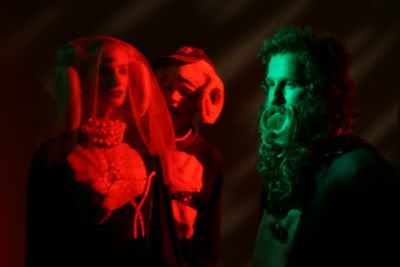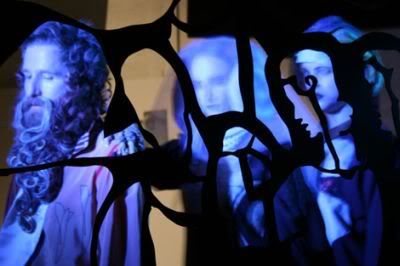Colour Sick
Elad Lassry and Emily Wardill currently have works on show in Bice Curiger's Illuminations exhibition at the Arsenale in Venice and both leave the same kind of haunted, floating jetsam of colour on your retina that remains when you stare too long at a bare bulb.
Their use of colour strikes. It is in turns nauseous and sentimental - ancient and antique. There is much more to the work than just their colour palettes but, among the over abundance of works in the Biennale, it is the sheer volume of their respective aesthetics that endures.
 Emily Wardill, Sick Serena and Dregs and Wreck and Wreck, (Detail), 2007, 16mm film.
Emily Wardill, Sick Serena and Dregs and Wreck and Wreck, (Detail), 2007, 16mm film. Wardill's film Sick Serena and Dregs and Wreck and Wreck (2007) takes religious tableaux from stained glass windows as its source and presents these fragmented and surreally vivid instances in hazy, full bleed primary colour, the action and dialogue physically cut and jarred by the rigours of the aesthetic.
Wardill writes;
Stained glass is broken up by lines so that you get cuts where you wouldn’t normally, a head will be sliced in half, a toe will be framed with a table leg and a bird will have its face obscured by a lead divider.*
She speaks also about stained glass' parallels with film in that both require light to pass through them in order to be brought to life. Stained glass is essentially a narrative form, albeit a freeze frame - a static slide locked in the carousel. It's interesting to consider the role of colour here, the notion that sense would be drained from these episodes if the colour was absent. Thus Wardill's film is over saturated - with the tangible feel of melted, theatrical gels - the heat of the colour is turned up in a bid to keep things alive, to keep things moving despite the wreck and wreck of the fragmented form. Failing to keep inside the lines to a point of a mania, sick and strange.
Elad Lassry's film work Untitled (Ghost), (2011) inhabits a world of only four colours. The striking setting is rendered almost limitless by the wall to ceiling coat of mushroom brown - its feel is usual, institutional, cautious but it quickly appears to us as a liminal non-space between life and death by virtue of the dual presence of the real dancers and the lone girl ghost - all moving in systematic rhythm, bold and ordered as punctuation or blown out pixels. As with Wardill's film, life is signified by hard colour and strong lines - the living dancer's bright lemon and jade sparks against the, faded forest tone of the ghost dancer's colours.
Elad Lassry. Untitled (Ghost), 2011, (detail) 16mm film.
She is more allied to the endless beige of the walls that surround them. Light passes through her and reveals the dead space, rather than holding fast with opacity as the other dancers do. They seem almost oblivious to their environment whereas the ghost in the image feels her way through the space - the retro crudity of the special effect leaving the sticky trace of her presence over the seemingly endless motion of the dance.
Like Wardill, Lassry deals with the philosophies entwined with the mechanics of photography. Both artists visualise Barthes' ghost in the machine - the curious mechanisms of light that bring back the dead. In Camera Lucida Barthes mentions his dislike for colour photographs, likening their painted on tones to the chalky, unnatural look of a cosmetics on a corpse. This same gaudiness is present in both films - extreme and specific the colour works to expose photography as always hyper representative of life - and of death.
Illuminations continues at the Arsenale and Giardini, Venice until 27th November. A solo exhibition by Elad Lassry begins at White Cube, Hoxton Square on 22nd September.
*Quoted in an interview with James Cahill. Read the full piece here.
*Quoted in an interview with James Cahill. Read the full piece here.





Comments